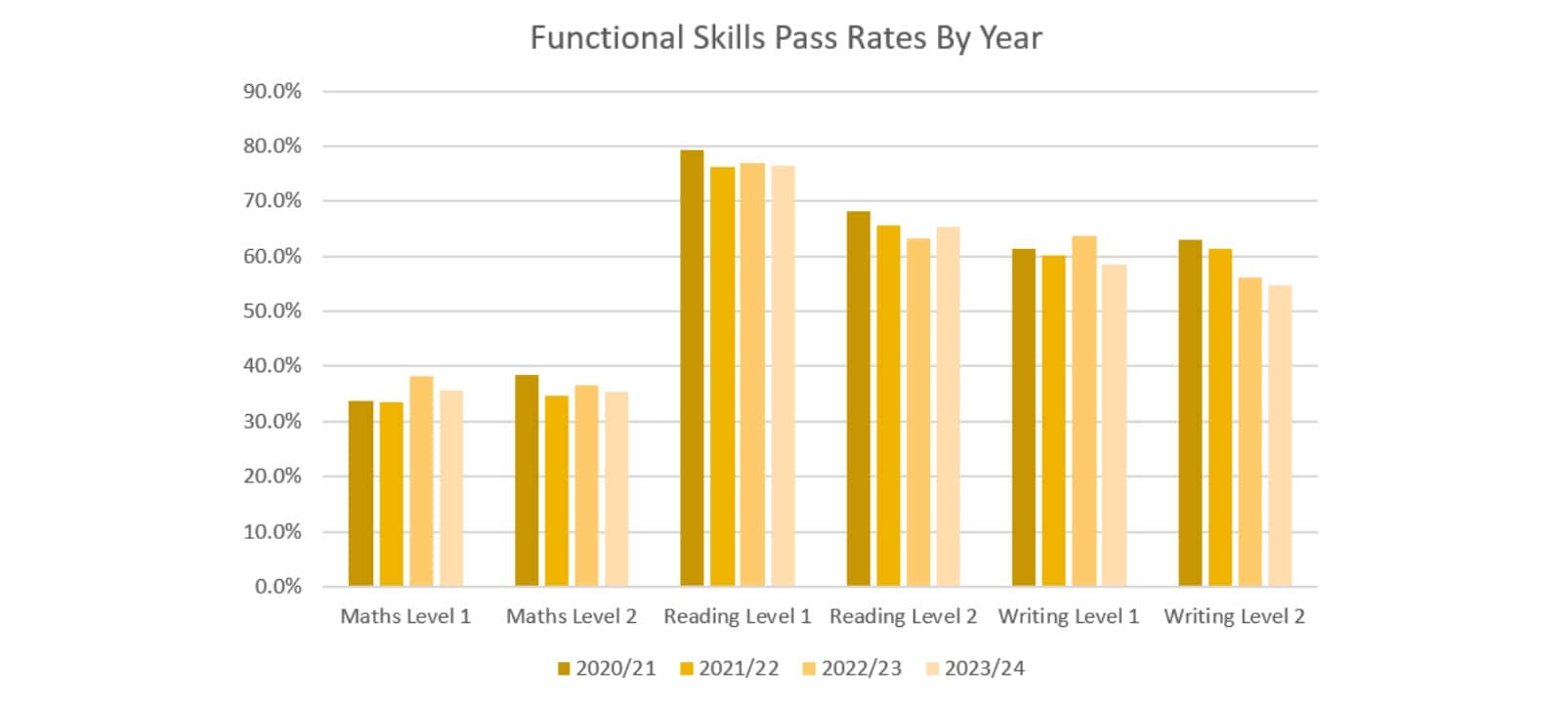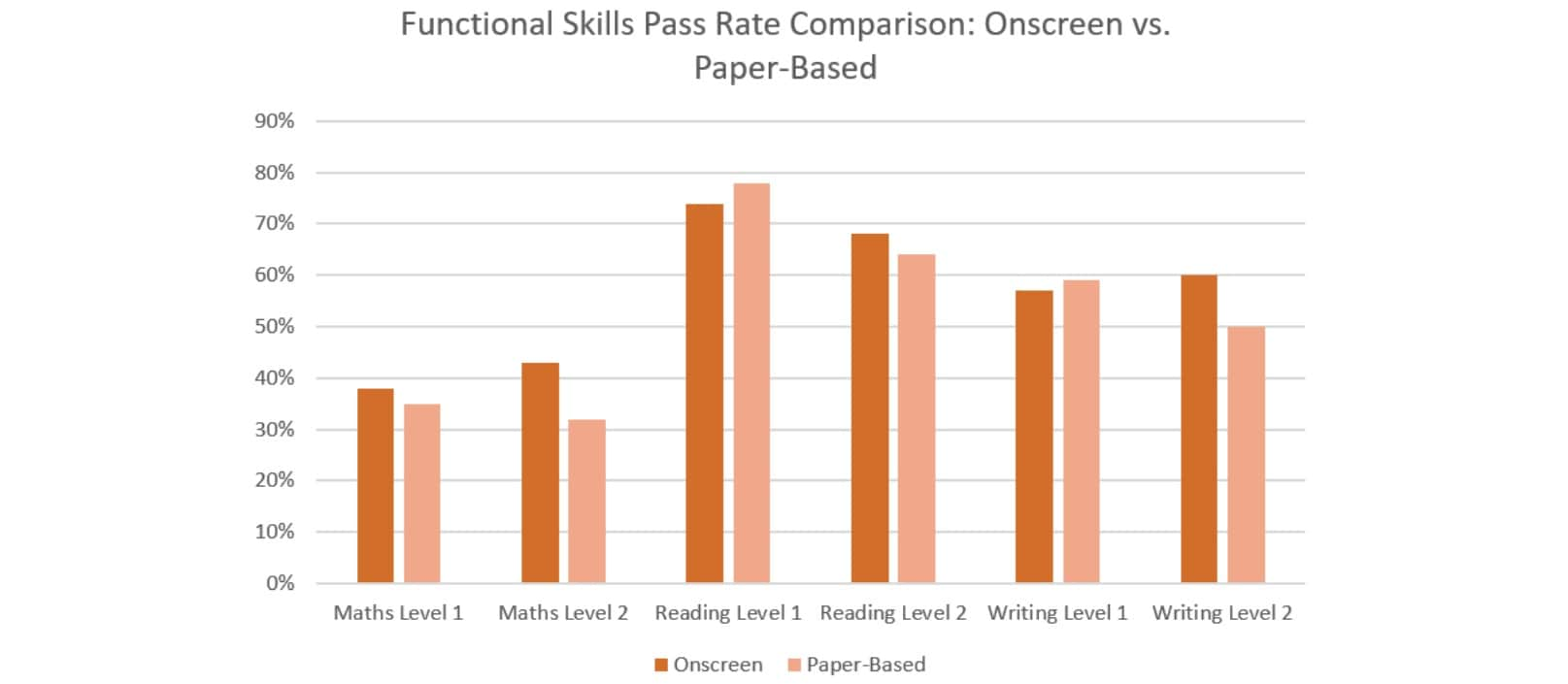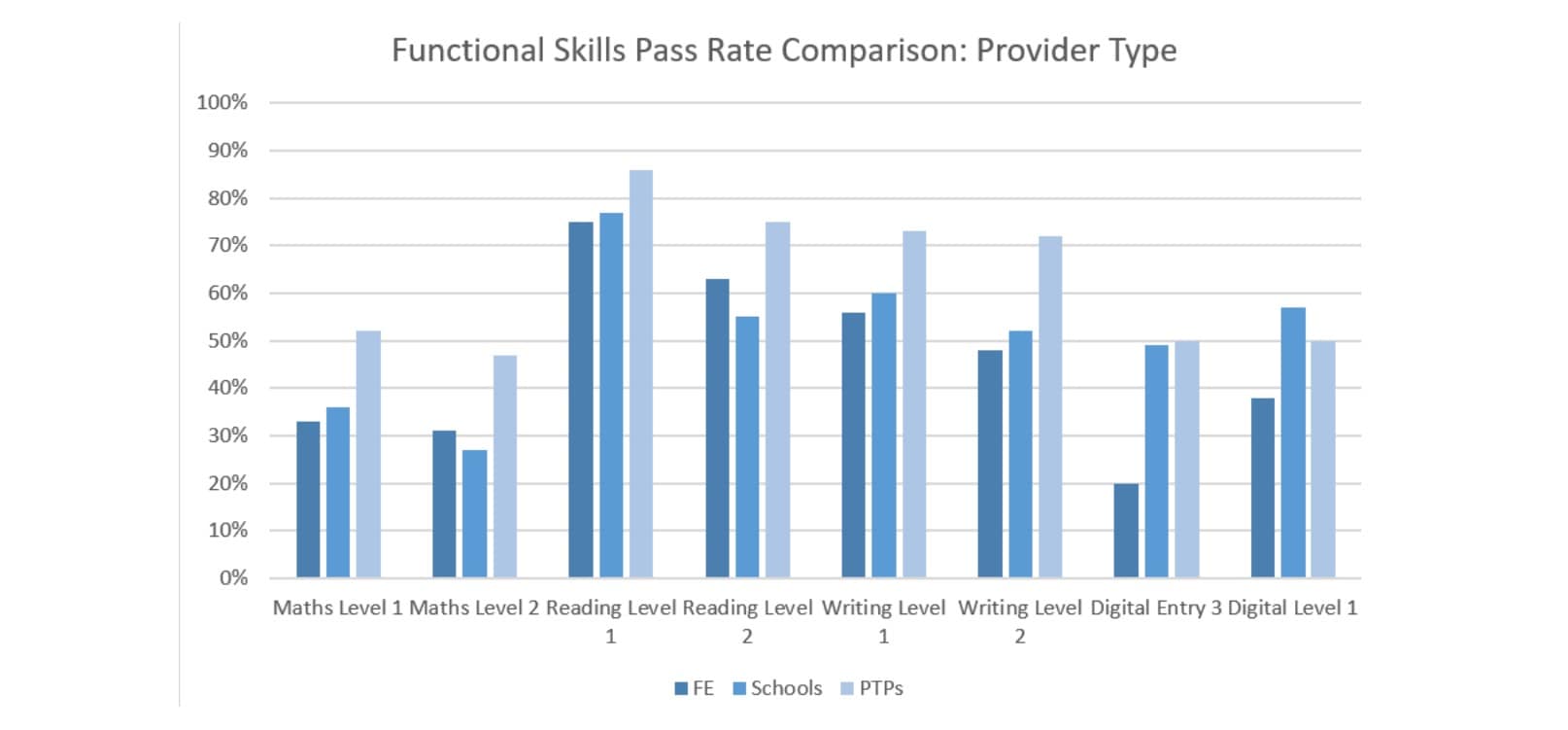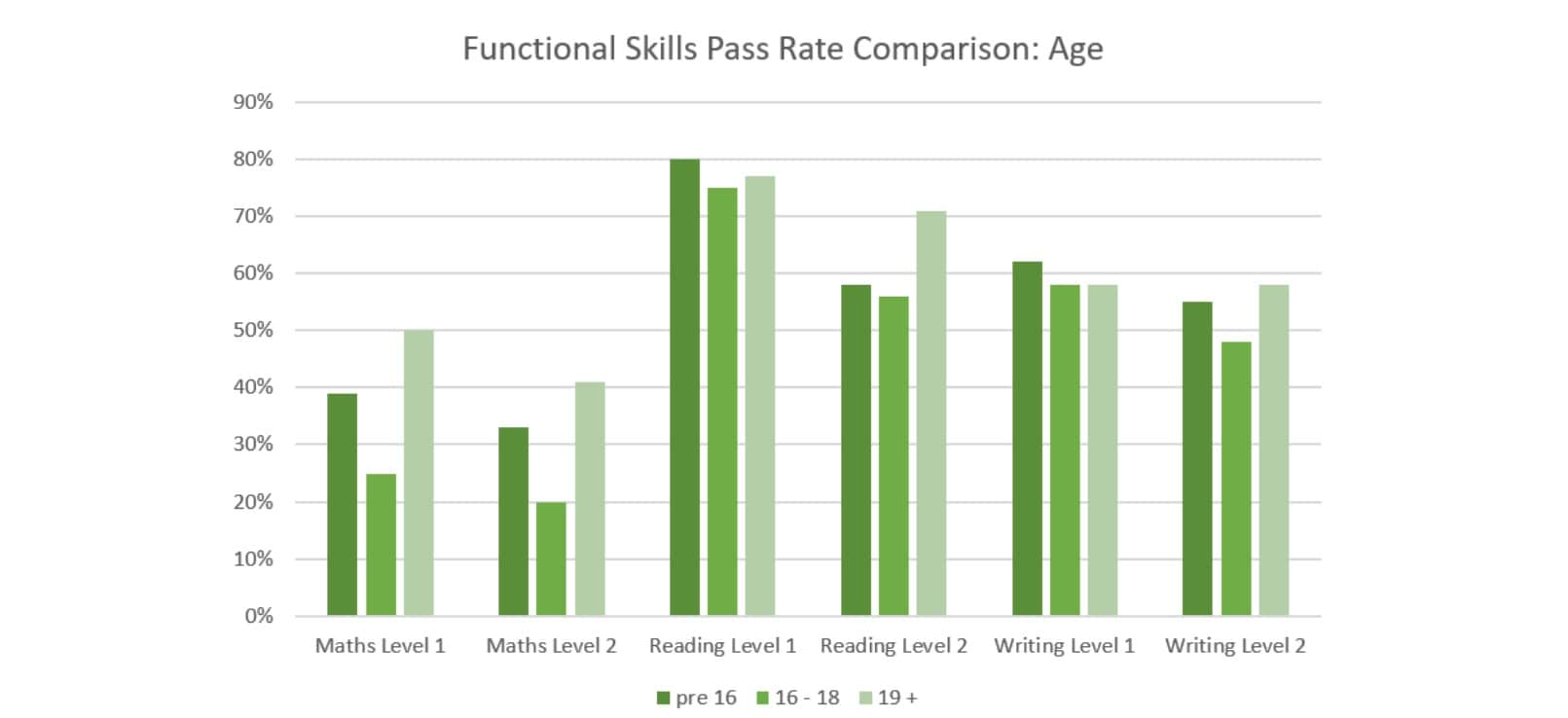Functional Skills Pass Rates 2023/24
Hello and welcome to Pearson’s Functional Skills blog for September 2024. As it is the end of the academic year, we will be looking at the pass rates for Functional Skills 2023/24. In addition, we will also be looking at the average marking times for our Functional Skills assessments.
The Year In Review
The 2023/24 academic year was another strong year for Functional Skills, with thousands of learners developing their skills and achieving qualifications to support their progression in study, life and work. Apprentices used it to help achieve their apprenticeships, adults to develop their skills for work, 16–19-year-olds to get qualifications to aid their progressions and careers and pre 16s to support their academic development.
The 2023/24 academic year also saw the launch of Digital Functional Skills and the retirement of Functional Skills ICT. Digital Functional Skills have an updated specification designed to support and develop learners.
Functional Skills continues to lead the way in terms of accessing assessments with both onscreen and paper-based on demand being utilised by centres. Adaptations such as Remote Invigilation, employer invigilation and a much greater use of online tools such as Teams and Zoom for Speaking, Listening and Communicating are now a common occurrence in Functional Skills helping to ensure that the assessment options suit the needs of all learners.
How Pearson Works Out Pass Rates
Pearson presents its pass rates a little differently to how a provider may do it. For us the pass rate is simple, the number of passes as a percentage of the number of tests taken. For many providers it is the number of passes as a percentage of the number of learners. These are not necessarily the same thing, especially when re-sits are factored in. As an example, albeit an extreme, impossible one, if a learner takes 100 tests and passes on test 100, the pass rate Pearson will provide is 1% and the pass rate the provider has is 100%. Please bear this in mind when looking at pass rates.
Entry Level Assessments and Speaking, Listening and Communicating
Pearson does not report pass rates for Entry Level learners in general and for the Speaking, Listening and Communicating component specifically as these are all internally assessed. For these learners we only see the claims for success and not the other attempts a learner might have had.
Pearson’s Pass Rates 2023/24
Below are Pearson’s overall pass rates. These are for all learners and are not filtered by age, gender or provider type.
| Assessment | First Time Pass Rate | Overall |
|---|---|---|
| Maths Level 1 | 44% | 36% |
| Maths Level 2 | 40% | 36% |
| Reading Level 1 | 83% | 77% |
| Reading Level 2 | 71% | 65% |
| Writing Level 1 | 66% | 59% |
| Writing Level 2 | 64% | 55% |
| Digital Entry 3 | 44% | 44% |
| Digital Level 1 | 54% | 54% |
A number of things strike me about these results:
- First-time success rates continue to be strong, showing when learners’ skills are supported and developed, there is reason to be positive.
- The difference in pass rates between maths and English is still there, which is, in part, due to the differences in size of the curriculum.
- Digital pass rates were as expected from the assessment team. There were very few resits in 2023/24 so there may well be changes over time. The second time pass rate in WBL, for example, was 87%.
First-Time vs Overall Pass Rates
Although the difference continues to improve, there is still an issue here. If you look below at the sector data, the difference in first-time vs overall pass rates in Work-Based Learning is minimal, but the difference in Further Education is much more significant. In subject and level the first-time pass rate is much higher in Work-Based Learning than in Further Education and Schools. Obviously, this will affect overall pass rates and suggests that some may need a more robust system for deciding when learners take their first assessments.
The key thing to understand is that many learners are taking assessments more than once or twice and are not necessarily successful. I found a learner with four fails at Level 1 writing, showing no progression in marks and a learner with five in Level 1 maths. This links back to the section on how Pearson presents our pass rates. The overall pass rate is less because the learners who fail the first time (according to the data), tend to fail again. This does not mean there are no instances of hope. There were learners who passed at the third or fourth attempt. The key is the support in place between assessments. We recommend spending time with learners who have failed looking at the coverage and range points they had less success on prior to any re-sit. This information can be found on ResultsPlus.
If ResultsPlus shows that a learner achieved less than 30% on their assessment, this suggests the learner may not have been fully prepared for the assessment or may have been entered at too high a level. We recommend spending more time with these learners, wherever possible, to facilitate their success before re-entering them
The final element of this is attendance at assessments. The data Pearson uses for pass rates does not include non-attendance but our figures show that almost 20% of Level 1 and Level 2 maths assessments in Further Education were not attended. While the flexible nature of the assessments means that they can be easily resat, this is increasing the burden on exams teams within providers.
Functional Skills Pass Rates By Year

The graph above compares the pass rates for the past four years. Pleasingly we can see that there has been a generally positive trend in pass rates for maths at Levels 1 and 2 and for English at Level 1. Hopefully this shows that the reformed qualifications have started to bed in across the board. The trend for Writing at Level 2 is a little more disappointing, though Pearson has put more support in place in 2024 to help providers. What is interesting is that our papers stay live across academic years, so the trends show more about the learners than the assessments themselves.
Onscreen vs. Paper-Based Assessments

Generally, there is very little difference between onscreen and paper-based pass rates, though they are slightly higher for onscreen tests at Level 2. This is not about the accessibility of the assessments, but more about the age of the learners taking them. The majority of onscreen assessments take place in work-based learning, where, as you can see below, the learners have a much higher pass rate compared to the norm. These learners are typically older than those in other provisions.
Onscreen maths assessments are performing well, and it may well be the added functionality of the assessments is supporting achievement here, especially the onscreen calculator reducing transcription errors.
Comparing Provider Types

Here we can see that work-based learning providers continue to outperform both schools and Further Education colleges. There are a number of reasons behind this:
- Age of the learners: as we will see below, learners in the 19+ demographic have a far higher success rate with Functional Skills, especially at Level 2.
- Motivation of the learners: For learners on an apprenticeship programme, Functional Skills is a mandatory part of the training programme (where necessary) as it is within Further Education. However, the key difference is that learners cannot complete their apprenticeship without passing their English and maths and this helps drive the learners towards success.
- Funding: There is no condition of funding for work-based learning learners, so providers are free to choose the most suitable maths and English course for their learners. This means there are more learners with grade 3 GCSE maths and English undertaking Level 2 Functional Skills qualifications. There is also a trend for grade 2 learners in Further Education to be entered into GCSE programmes despite the success rates being lower than those of the equivalent age taking Functional Skills. Many learners are leaving Further Education without a Level 2 qualification in English or especially maths. Encouraging grade 3 learners to take Functional Skills Level 2 in their second year of study would greatly remedy this and likely see an increase in Further Education success rates.
- Loss of learning: Younger learners are still struggling with the lost learning of the COVID lockdown years. This is something we will need to support learners with for many years to come.
Schools are continuing to improve their performance too, albeit with less learner numbers and we can see a strong performance in both Level 1 English and maths.
Comparing Age Groups

For the first time, Pearson are publishing results based on age. This makes for very interesting reading. We can see across all qualifications that there is a definite dip in success rates in the 16–18-year-old bracket. The majority of these learners, though by all means not all of them, were studying in FE Colleges. It does feel that the Condition of Funding is doing these learners a disservice, meaning they cannot study on programmes at their level of needs, rather is it based on past attainment. We can see without that limiting factor in other age groups that learners tend to be more successful. Comparing this data with Level 2 (4+) outcomes at GCSE in 2024 for 17-, 18- and 19-year-olds shows that success in Functional Skills maths at Level 2 is 5% points higher (20% vs. 15%) and significantly more in English where the success rate was 19.3% at GCSE Level 2.
Further Education Pass Rates 2023/24
| Assessment | First Time Pass Rate | Overall |
|---|---|---|
| Maths Level 1 | 43% | 33% |
| Maths Level 2 | 35% | 31% |
| Reading Level 1 | 83% | 75% |
| Reading Level 2 | 70% | 63% |
| Writing Level 1 | 65% | 56% |
| Writing Level 2 | 59% | 48% |
| Digital Entry 3 | 20% | 20% |
| Digital Level 1 | 38% | 38% |
WBL Pass Rates 2023/24
| Assessment | First Time Pass Rate | Overall |
|---|---|---|
| Maths Level 1 | 59% | 52% |
| Maths Level 2 | 51% | 47% |
| Reading Level 1 | 89% | 86% |
| Reading Level 2 | 78% | 75% |
| Writing Level 1 | 77% | 73% |
| Writing Level 2 | 76% | 72% |
| Digital Entry 3 | 50% | 50% |
| Digital Level 1 | 43% | 53% |
School Pass Rates 2023/24
| Assessment | First Time Pass Rate | Overall |
|---|---|---|
| Maths Level 1 | 40% | 36% |
| Maths Level 2 | 28% | 27% |
| Reading Level 1 | 79% | 77% |
| Reading Level 2 | 58% | 55% |
| Writing Level 1 | 63% | 60% |
| Writing Level 2 | 55% | 52% |
| Digital Entry 3 | 46% | 46% |
| Digital Level 1 | 57% | 56% |
Functional Skills Marking Times 2023/24
For 2023/24 Pearson has carried out a detailed analysis of the marking times for our Functional Skills:
| Type of Assessment | Number of Working Days |
|---|---|
| Overall Average | 10 |
| Onscreen | 8 |
| Paper-Based | 11 |
These marking times are based on test booking date. This means that the overall average and the paper-based average are inflated as this includes the “5-day window” for paper-based assessments to be taken and the time it takes for assessments to be returned to us. Without this, these figures would be much lower.
There are spikes in marking time, especially in November, March and May for onscreen and July for paper-based.
These pass rates continue to show the success of our learners, success that we should be celebrating. To continue this, Pearson will be supporting you all the way with up-to-date information and support throughout the year.
Chris Briggs - Product Manager Post 16 English, Maths and Digital Skills